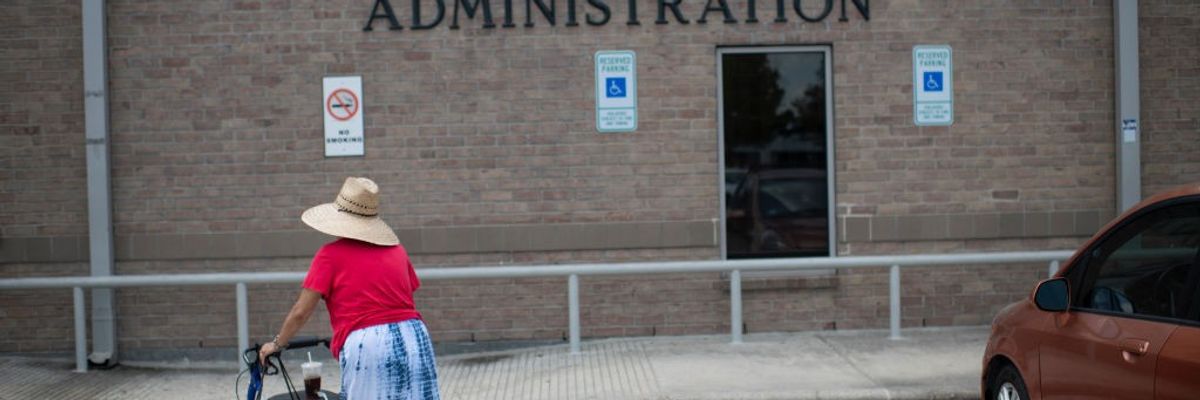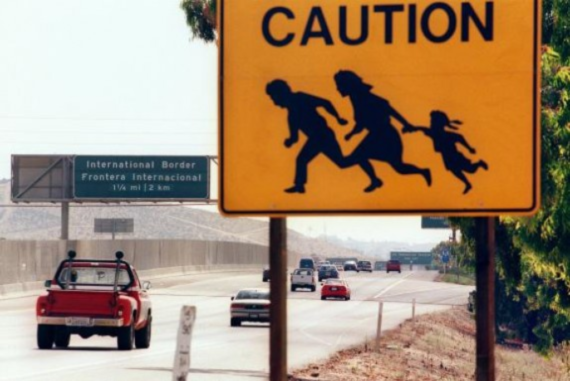All those charts and narratives ascribing Social Security the top spender of federal monies—and, thereby, implying the prime cause of the U.S. debt—need debunking.

A woman walks into a Social Security office in Houston, Texas on July 13, 2022.
(Photo by Mark Felix for The Washington Post via Getty Images)
FREDERIC H. DECKER
Mar 05, 2023
The narrative that Social Security eats up government revenue, driving the federal debt upward, is deeply entrenched in the Republican Party’s psyche. Former-Vice President Mike Pence insinuated such February during a private meeting with business leaders when promoting the age-old Republican wish to privatize Social Security. So maybe Social Security won’t be off the table, as GOP leaders earlier promised, as the current debate over the debt ceiling unfolds.
The public has favored shoring up Social Security with more taxes. But, also, concern over federal deficits has increased among both Republican-leaners and Democratic-leaners. Concern over deficits translates into concern over the debt. Consequently, debunking the myth Social Security feeds the debt seems an inherent requirement in gaining support for progressive proposals to reform Social Security. That, in addition to outlining how cutting benefits unduly inflicts harm within the aging population.
Now consider all those misleading charts. Those charts showing Social Security the top spender of federal monies surely don’t help foster favorable public opinion or keep the GOP benefit-cutting hatchet in the sheath. Nor do stories like that February 9 on PBS Newshour when a segment on Medicare and Social Security closed with this on the screen: "Almost a third of federal spending this fiscal year is expected to go toward Medicare and Social Security." PBS Newshour (which I support and watch regularly) is not alone, of course; the spending attributed to Social Security and other social programs is a recurrent theme during this debt-ceiling news cycle. Even the Treasury Department on one website has, at the time of this writing, a bar chart with Social Security the top bar consuming 19 percent of all spending.
Busting the debt myth can start with a report from the Government Accountability Office where stated how for years the Social Security program “built up reserves” from revenue collected that “were invested in federal government securities, reducing the amount that must be borrowed from the public,” including from other countries, to cover federal deficits. (By law surplus funds in Social Security have to be invested in government securities.)
Surpluses were possible, of course, given Social Security is largely funded by its separate payroll tax. Not totally by general revenue as likely some surmise, or haven’t considered questioning, from those typical charts on federal spending.
And, relatedly, not enough is made of this fact: Today, Social Security (formally, the “Federal Old-Age and Survivors Insurance [OASI] Trust Fund”) actually owns more U.S. debt, $2.7 trillion in Treasury securities, than the top two foreign governments, Japan with securities valuing $1.1 trillion and China with under $1 trillion.
It is true Social Security’s dedicated revenue in 2021 was not alone sufficient to cover benefits paid, as detailed in a recent report by the Social Security Board of Trustees. Although, it was sufficient in the preceding year with additional securities purchased then. But in 2021, the government had to reconcile payment for OASI-owned federal securities cashed in to cover that year’s shortfall. Put differently, installment payments on the loan from Social Security came due. This, admittedly, entailed some additional spending of general revenue. But not in sums making the program a major debt maker, particularly not relative to the deficit amounts caused by tax cuts during the Trump administration.
As outlined in the Trustees’ report (Table II.B1, page 7), $838.2 billion from Social Security’s separate payroll tax covered 84 percent of the $1,001.9 billion in operational costs during 2021. The other revenue sources were the routine interest paid on securities owned, the income tax on Social Security benefits, and $59.1 billion collected from the liquidation of some securities—a liquidation representing a small percent of the 2021 deficit. Granted, the deficit grew in 2021 to nearly $3,000 billion partly from Covid spending, but even if using for illustrative purposes the 2019 deficit amount of around $1,000 billion, the $59.1 billion would only have represented 6 percent of that deficit.
Shortfalls are now predicted to happen regularly each year whereby reserves (that is, owned securities) in the OASI trust likely will be depleted by 2034 if no reforms. Then only an estimated 77 percent of benefits due would be payable. But annual payments on securities cashed in isn’t á priori a dominant driver of deficits and debt, as the preceding paragraph reveals.
Aside from erroneously blaming Social Security for deficits swelling the debt, there is also a related and persistent argument that cutting benefits via raising the retirement age to 70 is necessary to control expenditures given the increasing life expectancy over the decades. But issues around life expectancy, ironically, actually contribute to disproportionate harm incurred by raising the retirement age again. Yes again, since a 1983 law increased the age from 65 to eventually 67.
Research has shown those of lesser means have experienced smaller improvements in mortality over the years. Conceivably, as life expectancy declined during the Covid-19 pandemic, this discrepancy was magnified. In any case, what is known according to the Congressional Research Service is raising the retirement age to reduce costs “would [because of their lower overall life expectancy] affect low earners disproportionately (i.e., reductions in their lifetime Social Security benefits would be considerably larger than for high earners).” By the way, privatization of Social Security would also disproportionately harm the well-being in retirement years of those with lesser means.
Research by the Social Security Administration also revealed that a sizable portion of those retiring before the full retirement age had health problems impairing the ability to work. And these early retirees more likely worked in physically demanding blue-collar occupations. This and other studies led the Congressional Research Service to observe that “early retirees who have work-related health impairment…would be disadvantaged” by an increased retirement age, which worth noting they also were by the earlier increase legislated in 1983.
Cutting benefits, in general, subverts the intended purpose of Social Security. And justification for cutting benefits is partly based upon the faulty claim Social Security continually increases the debt, ignoring most expenditures on the program do not entail general revenue. If only charts on federal spending demarcated expenditures on programs by revenue type. The one on general revenue only would show a percentage attributed to Social Security considerably less than advertised in the all-inclusive charts today.Essentially, the Social Security program has not contributed in any markedly way to the totality of deficits and associated debt. Rather, paradoxically, the program has historically loaned the government monies to cover the debt and, thereby, help pay for other federal programs. So, don’t blame Social Security for the sum of existing debt today accumulated over the years.
Our work is licensed under Creative Commons (CC BY-NC-ND 3.0). Feel free to republish and share widely.
FREDERIC H. DECKER is a Maryland-based sociologist and, today, an active writer with commentary appearing across local newspapers nationally. He earned his Ph.D. at Florida State University.






